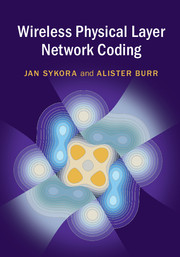Book contents
- Frontmatter
- Contents
- Preface
- Mathematical Symbols
- Abbreviations
- Part I Motivation and Gentle Introduction
- Part II Fundamental Principles of WPNC
- 3 Fundamental Principles and System Model
- 4 Components of WPNC
- 5 WPNC in Cloud Communications
- Part III Design of Source, Relay, and Destination Strategies
- Appendix A Background Theory and Selected Fundamentals
- References
- Index
3 - Fundamental Principles and System Model
from Part II - Fundamental Principles of WPNC
Published online by Cambridge University Press: 01 February 2018
- Frontmatter
- Contents
- Preface
- Mathematical Symbols
- Abbreviations
- Part I Motivation and Gentle Introduction
- Part II Fundamental Principles of WPNC
- 3 Fundamental Principles and System Model
- 4 Components of WPNC
- 5 WPNC in Cloud Communications
- Part III Design of Source, Relay, and Destination Strategies
- Appendix A Background Theory and Selected Fundamentals
- References
- Index
Summary
Introduction
This chapter is essentially all about basic definitions and classifications of various scenarios based on them. It is a bit tedious but necessary in order to develop a clear understanding of the terms. Also, the terms could have rather wide interpretations and we need to define them precisely. Proper classification of the techniques also helps to understand how they are mutually related, what they have in common, and how they differ. We attempt to present a highly modular view of the roles and functions of individual nodes in theWPNC network. This will help us later to develop various techniques (NCM design, decoding technique) that are universally usable in nodes serving a variety of roles.
We start with scenarios and models where we describe the roles of nodes, the constraints imposed by their radio interfaces, and various issues related to the topology of the network. Then we continue with the core hierarchical principle. It describes how data functions flowing through the network are encapsulated hierarchically. We also show how a direct neighborhood of the node affects the overall end-to-end description of the network.
Then we turn our attention back to the individual node. We show how its operation can, under very general conditions, be decomposed into front-end processing, node processing, and back-end processing operations. We show how the node processing operation is related to the many-to-one function of the source nodes’ data, which will lead to the definition of the hierarchical symbol, and we also define a form of information measure that is used to represent it to the rest of the network. Depending on a node's predecessor path in the network graph, this form of information measure can have various forms of usefulness from the point of view of the given node. We will define hierarchical information, hierarchical side-information (friendly interference), and classical interference.
Previous definitions help us to classify various strategies of the node. The node processing operation will be classified (e.g. amplify and forward, decode and forward, soft forward, compress and forward). Depending on the properties of the hierarchical symbol and its associated hierarchical NC map we will introduce full, minimal, extended, and lossy hierarchical maps.
- Type
- Chapter
- Information
- Wireless Physical Layer Network Coding , pp. 41 - 66Publisher: Cambridge University PressPrint publication year: 2018



